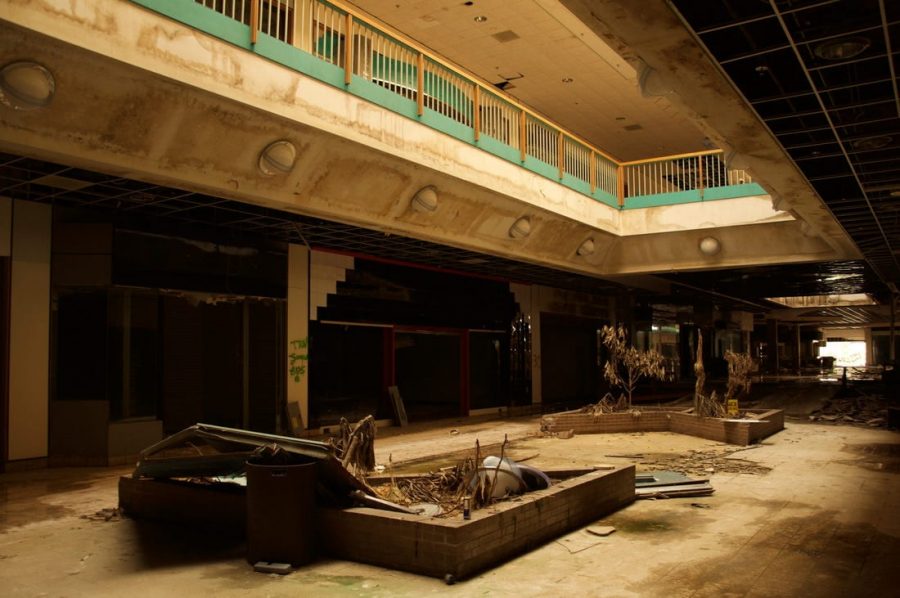COVID-19 is not the reason malls are closing; It’s only accelerating their expiration
Photo By: Seph Lawless Caption: Metro North Shopping Center in Kansas City, Missouri, sits vacant with what looks like decades of damage, but it only closed in 2014.
Dulles Town Center Mall was once a booming mall in Sterling, Virginia. Full of stores and restaurants, it was a central gathering place for the community. This past October, however, it went into foreclosure, a process in which a bank reclaims and sells a property that the owner failed to make payments on. How did this happen? And why may other malls like Dulles Town Center face a similar fate?
COVID-19 has damaged several industries such as entertainment and retail in the recent months. With restrictions on occupancy and consumers’ fear of exposure to COVID-19, malls in particular have felt the crushing effects of the pandemic. However, the virus is only exposing the holes in the business model of malls, not creating them. It is projected that 25% of American malls will disappear within the next three to five years by analysts at Coresight Research.
For years, financial experts and business analysts have been warning of the impending doom of malls if they don’t radically shift their business models. The major cause of this is the move to online shopping. According to studies by BigCommerce, 51% of Americans say they prefer online shopping — a majority in an industry previously dominated by brick and mortar stores.
In an interview with Forbes, Oliver Chen, a managing director of the retail and luxury department at the financial services firm Cowen Company, said successful retail businesses must focus on the three C’s: convenience, curation and culture.
The main area that malls are lacking is convenience. The core target market of malls are more affluent families who have the most money to spend. The issue with relying on this market is that it is common for such families to have a two-career household, reducing the amount of time they have to spend on shopping and leisurely activities.
That is where e-commerce comes into play. With a few clicks of a mouse, consumers can browse multiple brands, compare prices and purchase items in a matter of minutes. Malls, on the other hand, take consumers hours to find different stores, shift through items and wait in checkout lines. In order for malls to overcome this boundary, Chen believes they must heavily focus on the other two C’s: curation and culture.
In terms of curation, Chen advises malls focus on their local consumers’ needs. Currently, if an individual walks into the same store at a mall in two different states, they would most likely find the same items. This isn’t conducive to profit gain because the consumers need different items based on their geographic location. To fix this, malls should focus on how to best serve their local community and what stores might fit their needs.
Secondly, malls must focus on culture. This would mean incentivizing consumers to come to the mall for reasons other than shopping. Whether it be to go out to eat with friends or watch a movie at the mall. “Dining at home is nice, but the food doesn’t arrive as hot, it’s not presented as well and somebody always has to do the dishes when you’re done. So it’s not a substitute for dining out,” said Michael Brown, an employee of Kearney — a firm for consumer practice of global strategy and management consulting.
As a result of the pandemic several major retailers occupying spaces in malls across the country, such as J.C. Penney and J. Crew, have filed for Chapter 11 bankruptcy. With that has come many store closings, particularly in malls.
The Chief Operating Officer of Taubman Centers, one of the largest mall property owners in the country, Bill Taubman has drawn attention to the fact that many of the retailers filing for bankruptcy during the pandemic had significant challenges before it.
“The COVID crisis has impacted [malls] in a way that has deteriorated their business plan. But I don’t know that COVID was the cause of the issue to begin with,” Taubman said. This is because, just like malls retailers, brands have been struggling to dominate the market in both the e-commerce and physical storefront categories.
Which malls are able to survive the pandemic will come down to what class they are considered. Malls are divided into three classes depending on how much venue they generate based on the amount of sales per square foot of space.
Class A malls who are categorized to have $500 or more in revenue per square foot are projected to be able to survive COVID-19 because they have enough extra revenue to continue. This may not be the same fate for Class B and C malls who have $300 or more sales per square foot. Those are the malls that could face the tough decision to close permanently.
This is all to say that while COVID-19 has sped up the process of mall closings, it isn’t the main cause. Malls need to focus on shifting their business models to accommodate the modern shopper if they want to continue to prosper in the digital age.














